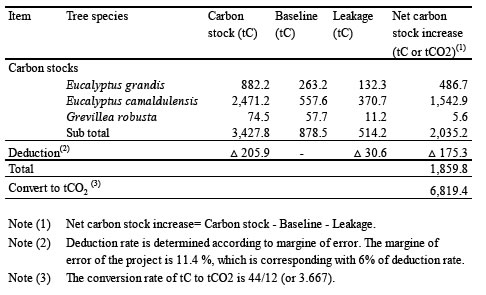Establishment of an implementation methodology for an afforestation/ reforestation clean development mechanism project targeting small-scale farmers
Description
The Clean Development Mechanism (CDM) is a system that emission reductions or removals of greenhouse gases (GHGs) to be achieved by GHG emission reduction projects carried out in developing countries are converted to carbon credits which can be added to the emission reduction targets of the Annex I countries (developed countries) of the Kyoto Protocol. The purpose of the study is to establish a practical methodology to obtain carbon credits (CERs) by implementing an afforestation/ reforestation CDM (A/R CDM) project targeting small-scale farmers (SSFs) in Paraguay as a part of rural development.
The CDM Executive Board of UNFCCC issued 6,819 tCO2 of CER to the A/R CDM project of JIRCAS titled as "Reforestation of croplands and grasslands in low income communities of Paraguarí Department, Paraguay" in August 2013 (Table 1, Figure 1). The CERs were the first in Latin America issued to the A/R CDM project targeting SSFs. This CDM project realized the effective use of SSFs’ lands through introducing agro-forestry and silvo-pasture based on the needs of SFFs (Figure 2).
In spite of expected large social significance of A/R CDM project targeting SSFs, the growth of trees was poor or irregular due to low capability of participants and degraded lands susceptible to drought. Carbon stocks were quantified by establishing sample plots not with a unit area but with a certain number of trees to correspond to the irregularity of SSFs’ forests. The study clarified that the A/R CDM project targeting SSFs generated quite less carbon stocks or CERs than the planned amount of them (Table 2).
The implementation methodology of an A/R CDM project targeting SSFs from formulation to implementation including the results of monitoring activity conducted in 2012 was recommended and developed as manuals which were uploaded in the JIRCAS homepage. In addition, the necessary documents for the issuance of CERs such as project design document and monitoring report as well as validation and verification reports prepared by the designated operational entity were published on the web site of the UNFCCC.
Expecting high sustainability, the methodology of JIRCAS is intended to promote reforestation by self-responsibility and beneficiary pays principle of participant farmers. The methodology can be used for carbon sequestration projects applied to A/R CDM, REDD+ and voluntary carbon offset system which involve unorganized SSFs in Latin America.
If an A/R CDM project is proposed, a break-even CER unit value of the proposed A/R CDM project should be calculated by financial analysis; then, should be compared to an assumed market value or the minimum unit cost obtained by JIRCAS in order to ensure the viability of CER acquisition. The keys to realize sustainable reforestation project with the beneficiary-pays-principle are to select project area with farmers’ high needs for tree plantation and to promote self-help efforts by means of awareness raising activities.
Figure, table
-
Table 1. Increase of GHG removals by sinks in the A/R CDM project in Paraguay
-
Table 2. Comparison of planned reforestation area with monitored reforested area
-
Figure 1. Flow of processes from the start to the acquisition of CER of the A/R CDM project in Paraguay
-
Figure 2. Photographs of established forest in the A/R CDM project in Paraguay
- Affiliation
-
Japan International Research Center for Agricultural Sciences Rural Development Division
- Classification
-
Technical
- Research project
- Program name
- Term of research
-
FY2013(FY2011-2013)
- Responsible researcher
-
Matsubara Eiji ( Rural Development Division )
Watanabe Mamoru ( Rural Development Division )
MIERUKA ID: 001737Shiraki Shutaro ( Rural Development Division )
- ほか
- Publication, etc.
-
Matsubara, et al. (2009), Journal of the Japanese Socienty of Irrigation, Drainage and Rural Engineering, 77(11): 27-30
Eiji Matsubara, (2012), JIRCAS International Agriculture Series, 20
Matsubara, et al. (2014), Journal of the Japanese Socienty of Irrigation, Drainage and Rural Engineering, 82(2): 127-130
Guía General - Desarrollo Rural basado en el Mecanismo de Desarrollo Limpio de Reforestación
https://www.jircas.go.jp/ja/publication/manual_gudeline/33Guía General - Desarrollo Rural basado en el Mecanismo de Desarrollo Limpio de Reforestación
Reforestation of croplands and grasslands in low income communities of Paraguarí Department, Paraguay, http://cdm.unfccc.int/Projects/DB/TUEV-SUED1245074838.6/view
- Japanese PDF
-
2013_A01_A3_ja.pdf292.27 KB
2013_A01_A4_ja.pdf401.46 KB
- English PDF
-
2013_A01_A3_en.pdf187.87 KB
2013_A01_A4_en.pdf248.46 KB
- Poster PDF
-
2013_A01_poster.pdf320.66 KB




